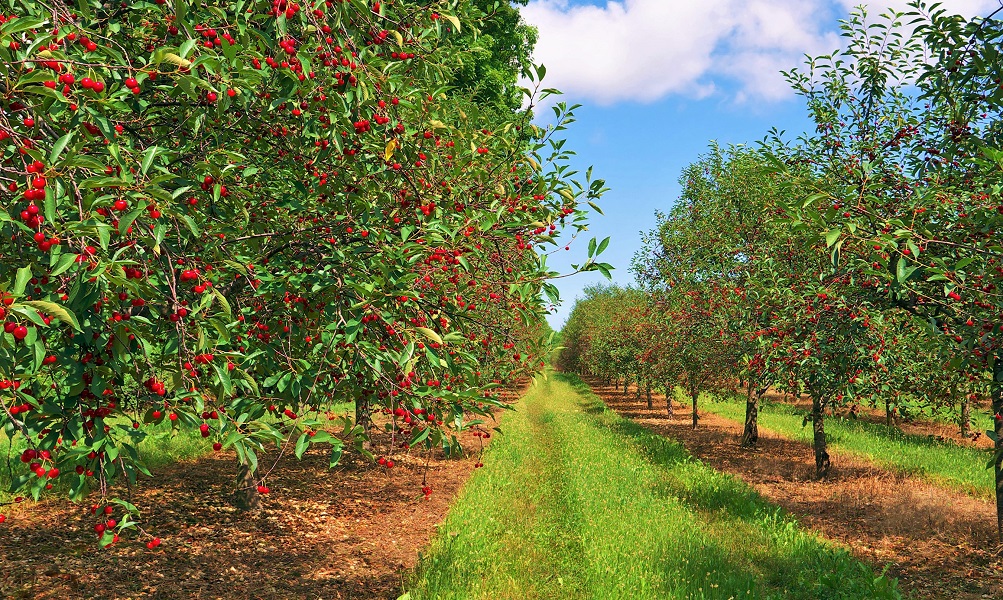Cherries, with their luscious fruits and beautiful spring blossoms, are just delightful. For any gardener the prospect of planting cherry trees can be both exciting and daunting. This guide aims to simplify the process, offering practical advice on selecting the right cherry trees for your orchard and tips on their care. Our focus will be on varieties best suited to the British climate, understanding their needs, and ensuring a bountiful harvest.
Selecting Cherry Trees for Your Orchard
1. Understanding Cherry Tree Types
Before diving into specific varieties, it’s crucial to understand the two main types of cherry trees: sweet cherries (Prunus avium) and sour cherries (Prunus cerasus). Sweet cherries, often eaten fresh, thrive in warmer, sheltered spots with less risk of frost. In contrast, sour cherries, commonly used in cooking and baking, are hardier and can tolerate cooler conditions, making them more versatile for the variable British climate.
2. Choosing Varieties Suitable for Britain
The key to a successful orchard is selecting varieties that match your local climate and soil conditions. For sweet cherries, consider ‘Stella’ and ‘Sunburst’, both self-fertile varieties reducing the need for multiple trees to ensure pollination. ‘Stella’ is particularly noted for its resistance to splitting from rain, a common issue in the UK. Sour cherry enthusiasts should look at ‘Morello’ and ‘Nabella’, renowned for their adaptability and robust flavour, perfect for those classic British cherry pies.
3. Pollination Partners
While some cherry trees are self-fertile, many require a pollination partner to bear fruit. Understanding the flowering group of your chosen variety is essential. Cherries are categorized into flowering groups based on their bloom time. Planting varieties that flower simultaneously can significantly enhance pollination and, consequently, fruit production. For those with limited space, consider dwarf or semi-dwarf varieties, which still require a compatible pollinator but take up less room.
Planting and Early Care
1. Site Selection
Cherry trees thrive in well-drained, fertile soil with a neutral pH. Choose a sunny, sheltered location to protect blossoms from late frosts, a common challenge in Britain. Avoid frost pockets and ensure good air circulation to reduce the risk of diseases.
2. Planting Techniques
The best time to plant cherry trees is in the dormant season, from late autumn to early spring, avoiding periods of frost. To accommodate the root ball, excavate a hole that is twice as broad and deep. Incorporating well-rotted organic matter can improve soil structure and fertility. Ensure the graft union (the point where the rootstock meets the scion) is above soil level to prevent scion rooting, which can negate the dwarfing effect of the rootstock.
3. Watering and Mulching
Initially, watering is critical, especially during dry spells. Mulch with organic material to retain moisture, suppress weeds, and gradually improve soil health. However, keep the mulch away from the tree trunk to avoid rot.
4. Feeding
In spring, apply a balanced granular fertilizer around the base of the tree, following the manufacturer’s instructions. Cherry trees benefit from additional potassium in late summer to promote fruit quality.
5. Pruning
Pruning in the first few years should focus on establishing a strong, balanced framework of branches. After that, prune to maintain shape, remove dead or diseased wood, and encourage air circulation. Winter is the best time for major pruning, while summer pruning can help manage the tree’s size and shape.
Ongoing Care for Cherry Trees
Ensuring your cherry trees remain healthy and productive requires attention to a few key areas of ongoing care: watering, feeding, and disease management. Regularly monitoring your trees will help you spot any issues early and take appropriate action.
1. Watering
Cherry trees, especially during their formative years, need consistent moisture to establish their root systems. In periods of prolonged dryness, it’s crucial to water deeply. For mature trees, a good soaking once a week is preferable to frequent, shallow waterings, as it encourages deeper root growth. Applying a layer of mulch can aid in keeping soil moist.
2. Feeding
Annual feeding helps maintain vigorous growth and fruit production. In early spring, apply a general-purpose fertilizer to support new growth. Additionally, a mid-summer application of a potassium-rich fertilizer encourages fruit development and improves resistance to pests and diseases. Be careful not to overfertilize the plant because doing so will result in the plant producing more leaves than fruit.
3. Pruning for Health and Productivity
After the initial training period, annual pruning is essential to maintain tree health and fruit quality. Remove any dead, diseased, or crossing branches to improve air circulation and light penetration, crucial for fruit ripening and reducing disease risk. Pruning should be carried out in late winter or early spring before the growing season starts.
4. Pest and Disease Management
Cherry trees in Britain can be susceptible to several pests and diseases, including cherry blackfly, aphids, and bacterial canker. Regular inspections help catch problems early when they’re easier to manage. Use environmentally friendly treatments whenever possible, such as horticultural oils for controlling aphids. For diseases like bacterial canker, good garden hygiene and pruning out infected wood during dry weather can help control the spread.
Harvesting and Enjoying Your Cherries
The reward for your care and attention is a bountiful harvest of cherries. Timing is crucial; cherries should be picked when fully ripe for the best flavor, typically from late June through July in Britain, depending on the variety and local climate. Harvest on a dry day, and consider netting your trees earlier in the season to protect the fruit from birds.
Conclusion
Growing cherry trees in your orchard is rewarding. By selecting the right varieties for the British climate, providing careful planting and early care, and maintaining vigilance with ongoing cultivation practices, you can enjoy a rich harvest of these delightful fruits for years to come.





